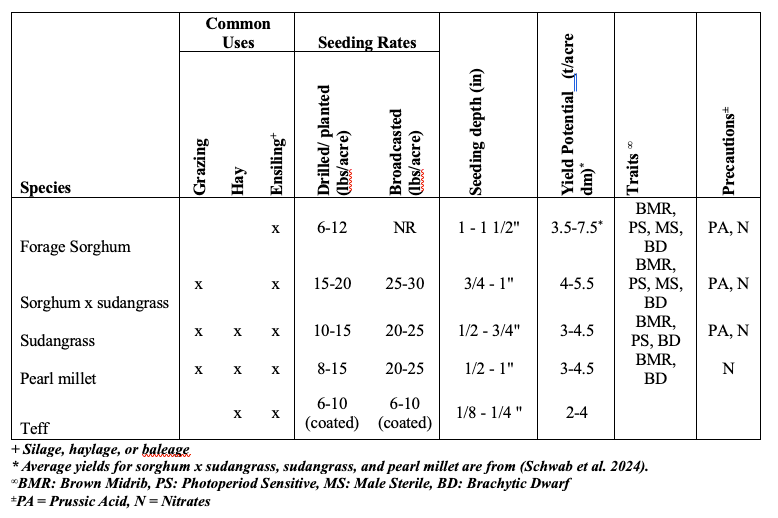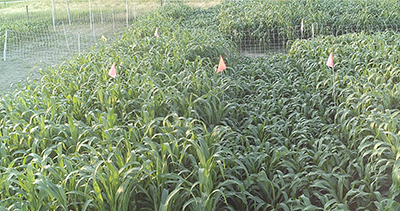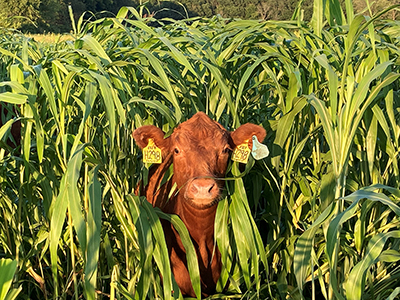Growing Beef Newsletter
June 2024, Volume 14, Issue 12
Maximizing Forage Production with Summer Annuals: Strategies and Insights
Shelby Gruss, ISU extension forage specialist
Summer annuals are valuable to forage production systems due to their heat and drought tolerance. These high-yielding crops are typically ready for grazing within 40-45 days under optimal conditions, making them ideal for double cropping systems. They provide excellent options for silage, baleage, hay, and grazing. This spring has delayed planting and cover crop termination due to consistent rainfall throughout the state. Summer annuals are an excellent opportunity for late planting. Summer annuals could be a viable option to plant until early/mid-July for forage due to their quick growth habit.
Here are management strategies to consider when producing summer annuals for forage (Table 1).
Summer Annuals
There is a large variety of summer annuals, but for this publication, we will focus on the most used summer annuals for forage in Iowa: forage sorghum, sorghum x sudangrass, sudangrass, teff, and pearl millet.
Forage sorghum is generally the highest yielding of the three. Forage sorghum is usually used for silage production or green chop. Its thick stems make it challenging to dry for hay, and its taller growth habit makes it difficult to manage in a grazing system.
Sudangrass is commonly used in multi-cut systems for hay, baleage, or silage. Its thinner stems make dry-down possible but can still be problematic in Iowa due to humidity and cooler environment. Generally, it yields less than forage sorghum and sorghum x sudangrass, although some sudangrass hybrids can produce similarly to sorghum x sudangrass.
Sorghum x sudangrass is probably the most used sorghum and summer annual in the upper Midwest (excluding corn). It has good yields and is multi-purposeful: grazing, baleage, silage, and hay. However, hay may be difficult for the reasons above, and its stems are slightly larger than sudangrass, making it even more challenging to dry down. It also regrows well and is commonly used in multi-cut systems. (Figure 1)
Teff generally does not have as high yields as the other warm-season annuals but typically has higher nutritive value. It is commonly used in hay or ensiling for baleage or haylage. Teff has a shallow root system, and grazing can uproot the plants, so not typically recommended. Lastly, teff is unlikely to have nitrate toxicity and no prussic acid production but is susceptible to lodging, particularly during grain production.
Pearl millet generally yields lower than forage sorghum and sorghum x sudangrass but does not produce prussic acid. However, it can be used for various purposes, including grazing, hay, and ensilaging. Forage quality can vary depending on traits but typically is slightly lower than sorghum x sudangrass and similar to sudangrass.
Planting
Seeding should be delayed till the top 2 inches of soil are above 60 to 65 °F and ensure the forecast for the following two weeks remains warm. Summer annuals do not withstand cool temperatures well, and planting below 60 °F could lead to poor stands. Soil pH should be between 6.0 and 7.5, but the optimum range is between 6.5 and 7.0. Seeding rates can vary greatly depending on the summer annual. If planting teff, ensure a firm seed bed. Teff has tiny seeds that can settle deeper into the seedbed, leading to poor establishment.
Trait consideration
There are multiple traits to consider when planting summer annuals. The traits discussed may be available in some but not all summer annuals. Some traits on the market to consider are brown midrib (BMR), brachytic dwarf, and male sterility. The most well-known is the brown midrib trait (BMR). The BMR trait has decreased lignin content. Lignin is not very digestible to ruminant animals, leading to lower nutritive value. The BMR trait decreases the plant's overall lignin content, leading to an increase in NDF digestibility.
Another common trait in forage sorghum is photoperiod sensitive or non-heading varieties. In the upper Midwest, most summer annuals will be photoperiod insensitive and rely on growing degree days to flower, similar to corn. However, photoperiod-sensitive varieties are available. Photoperiod-sensitive varieties will not produce a head until late fall, leading to higher biomass production. However, this can be problematic when producing silage because they only dry down for fermentation once a hard frost causes them to wilt. This variety benefits grazing and hay production systems because they will maintain high nutritive value throughout the summer and early fall with no seed production Figure 2.
Brachytic dwarf varieties are a trait to increases the leaf-to-stem ratio. The trait shortens stem length and overall height, increasing the leaf-to-mem ratio. Stems can contain higher structural components such as lignin, cellulose, and hemicellulose to decrease NDF digestibility. It also can better withstand lodging.
Male sterility is a trait where the pollen is sterile, and the plants will not produce any seed unless foreign pollen is introduced to the plants. This could lead to higher crude protein and sugar levels because the plant's leaves will not increase in biomass or fiber after heading out. Without the seed sink and continuous biomass production, the leaves will hold the sugars they have produced and are still producing through photosynthesis as cell components, not fiber or within the seed. This can be beneficial because sorghum seed is difficult for animals to digest, so keeping it in the leaves makes it more available for animals to increase nutritive value.
Precautions
Be aware most summer annuals can cause nitrate toxicity and forage sorghum, sorghum x sudangrass, and sudangrass can cause prussic acid toxicity in livestock. Summer annuals can be used safely with proper management and testing if there is a concern.
Overall, summer annuals can be an excellent opportunity to maximize production throughout the summer, supply a forage source throughout the summer slump of our cool-season pastures, work well in a forage double cropping system with winter annuals, and can be a savior crop in adverse years.
Table 1: Summer annual species uses, seeding management, yield, and precautions.

References
Schwab, Denise L., Josh Michel, Beth Reynolds, Ken T. Pecinovsky, and Shelby Gruss. 2024.
"Evaluating Rotations of Winter Annual and Summer Annual Forages for Yield, Nutritional Value, and Economic Sustainability as Forage Resources for Beef Cattle in Northern Iowa." Iowa State University Animal Industry Report 1 (1). https://doi.org/10.31274/air.17746.
This monthly newsletter is free and provides timely information on topics that matter most to Iowa beef producers. You’re welcome to use information and articles from the newsletter - simply credit Iowa Beef Center.
Archived issues


